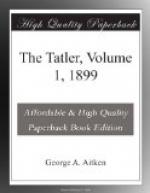Probably the Tatler was started by Steele without any very definite designs for the future. According to the first number, published on April 12, 1709, the aim was to instruct the public what to think, after their reading, and there was to be something for the entertainment of the fair sex. The numbers were published three times a week, on the post-days, at the price of one penny. Each paper consisted of a single folio sheet, and the first four were distributed gratuitously. Steele probably thought that his position of Gazetteer would enable him to give the latest news, and he says that these paragraphs brought in a multitude of readers; but as the position of the Tatler became established, the need for the support of these items of news grew less, and after the first eighty numbers they are of rare occurrence. Quite early in the career of the paper Addison, speaking of the distress which would be caused among the news-writers by the conclusion of a peace, said that Bickerstaff was not personally concerned in the matter; “for as my chief scenes of action are coffee-houses, playhouses, and my own apartment, I am in no need of camps, fortifications, and fields of battle to support me.... I shall still be safe as long as there are men or women, or politicians, or lovers, or poets, or nymphs, or swains, or cits, or courtiers in being."[1]
The subject of each article was to be indicated by the name of the coffee-house or other place from which it was supposed to come: “All accounts of gallantry, pleasure, and entertainment shall be under the article of White’s Chocolate-house; Poetry, under that of Will’s Coffee-house; Learning, under the title of Grecian; Foreign and Domestic News you will have from Saint James’s Coffee-house; and what else I have to offer on any other subject shall be dated from my own Apartment.” For some time each number contained short papers from all or several of these places; but gradually it became usual to devote the whole number to one topic. The motto of the first forty numbers was “Quicquid agunt homines ... nostri farrago libelli”; but in the following numbers it was changed to “Celebrare domestica facta”; and afterwards each number generally had a quotation bearing upon the subject of the day. Writing some time after the commencement of the fatter, Steele said, in the Dedication prefixed to the first volume, “The general purpose of this paper is to expose the false arts of life, to pull off the disguises of cunning, vanity, and affectation, and to recommend a general simplicity in our dress, our discourse, and our behaviour.” And elsewhere he says: “As for my labours, which he is pleased to inquire after, if they but wear one impertinence out of human life, destroy a single vice, or give a morning’s cheerfulness to an honest mind; in short, if the world can be but one virtue the better, or in any degree less vicious, or receive from them the smallest addition to their innocent diversions;




